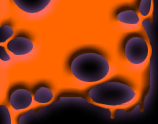|
Bibron's Geckos should be kept in an environment with an average daytime temperature between
75 and 85 degrees Fahrenheit. They should be provided with a basking lamp with temperatures between 95 and 110 degrees Fahrenheit.
Nighttime temperatures average between 65 and 75 degrees Fahrenheit. Bibron's Geckos should be given light from an ultraviolet
lamp, between twelve and fourteen hours a day. The ideal humidity of 65 degrees can be achieved by daily misting.
The Bibron's Gecko should be fed insects that have been dusted with a calcium supplement three
or four times a week. A multivitamin is recommended about once or twice a week. While growing, juveniles can be fed twice
a day. A shallow water bowl should be provided.
A single Bibron's Gecko can be housed comfortably in a twenty-gallon terrarium with a screened
lid for ventilation. The enclosure should have hiding areas, a shaded area to cool off, climbing branches and a basking area.
Plants, either natural or artificial, are also recommended. Bibron's Geckos are best kept separately unless breeding.
Bibron's Geckos should not be handled excessively. They are very fast moving and have sensitive
skin, which can be damaged very easily. They are not good pets for children and should only be handled by children in the
presence of an adult. | 
